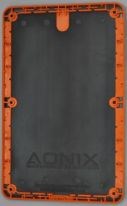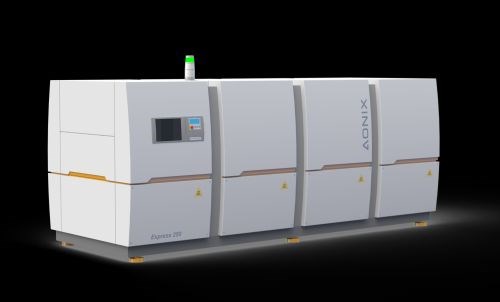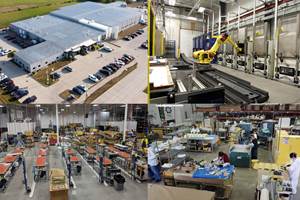Aonix Advanced Materials system combines material, machinery
Ottawa-based company develops turnkey technology for high-performance, thermoplastic composites at volumes of up to 1 million parts per month.

Aonix tablet chassis made with carbon fiber, Ultra-S matrix and Express machine.
Aonix Advanced Materials (Ottawa, Ontario, Canada) showed off what its technology can produce at JEC 2014 (March 11-13, Paris, France). An ultrathin (0.7mm/0.028-inch), tablet computer chassis (also called a unibody or back plate plus edge frame), made from 11 plies of unidirectional carbon fiber molded into a thermoplastic composite based on Aonix’ Ultra-S (sulfone-based) matrix material using an Aonix Express molding machine is 50 percent thinner and 65 percent lighter than a typical aluminum version. It can also be produced in volumes as high as one million parts per month. Oh, and the edge frame (shown in orange) can be overmolded onto the chassis within the same equipment. The company received significant interest from Airbus and many other composites users during the JEC expo and looks forward to a wide variety of development programs as a result.
Aonix was founded by president and CEO, Jerome Le Corvec, in 2008. After working with composites for many years, Le Corvec was frustrated with the high labor cost and slow manufacturing processes in the industry. He envisioned the capability to produce high performance composites with the speed and complex molding of plastic injection. However, he found that most injection machines were not designed for the materials being used and most materials were not designed for the final part properties desired. Thus, Aonix has developed a four-pronged approach that delivers to its customers a complete turnkey system for producing high performance composites: (1) Aonix UltraMaterials, (2) Express high capacity molding machines, (3) guaranteed, on-time supply of UltraMaterials blanks, and (4) an integrated 24-7 remote-monitoring and predictive maintenance system.
With the UltraMaterials product line, LeCorvec sought to enable injection molding of ultra high performance composites that would demonstrate a true cost and performance advantage over epoxy, the conventional matrix base for most composites. The UltraMaterials Solution includes the Ultra-P, Ultra-S and Ultra-I families of polymers, based on modified paraphenylene, sulfone and polyimide systems, respectively, each family having up to four variants. Composites made with Ultra-I matrix systems (modified polyimide) show thermo-mechanical properties that are comparable to PEEK-based composites, while those using Ultra-S matrix systems (modified sulfone) compete head-to-head with conventional epoxy-based composites. However, all of the systems are amorphous, which is key for quick processing. Le Corvec recalls, “In the beginning of thermoplastic composites, it was perceived that crystalline polymers always have better properties, while amorphous systems, like nylon, always have lower properties. This is no longer the case.” He knew crystalline systems were not the way to go because of their issues with very sensitive and long cooling cycles in order to form critical crystalline structure and avoid warpage in the final part. Thus, Aonix UltraMaterials were inherently designed to be molded quickly and also to be compatible with overmolding using a wide range of polymers.
Aonix announced recently that Solvay Specialty Polymers (Brussels, Belgium) has acquired a minority stake in the company. Le Corvec comments that Solvay has the largest portfolio of thermoplastic polymers and also a complimentary selection to Aonix’ own materials. “Our partnership with Solvay opens many doors with overmolding,” relates Le Corvec, “but which materials are used in a given project are determined by our customers, some of which have to meet specifications which mandate a specific materials supplier. A specification requires BASF? No problem. We also have superb material systems, but our focus must be on what the customer needs for their specific part because our objective is to provide a solution, not just a material.”
The stages of Aonix solution development begin with Design and Prototyping. “Our customers are the parts expert, so they will tell us what they need to make,” explains Le Corvec. “We are the materials and process experts, so we will develop the materials and machinery combination to meet their specific requirements.” In the next stage, Aonix will build the custom-tailored production equipment, followed by extensive pre-production testing where both materials and machines can be tweaked if needed. Finally, the machines will be transferred to the customer location, put through post-installation prove-out and Aonix supply of blanks will be established. When asked if manufacturers will have to completely retool in order to take advantage of Aonix’ technology, Le Corvec replies, “They could probably re-use robotic elements and also injection machines for overmolding.” He notes that Aonix Solution technology extends traditional thermoplastic molding capability to include sandwich structure, for example, and welding of outer Class A shells to inner structural shells.

Example of Aonix' Express molding machines.
As far as the process, Le Corvec says that it is close to stamping, but highly optimized and fully automated. Unlike conventional open presses, in which technicians place material, operate the press and remove the material, all the while trying to troubleshoot forming and molding issues, the Express machines are completely enclosed and designed on a per-case basis to repeatedly produce high-quality parts to customer specifications. “The process must be reliable regardless of the operator,” says Le Corvec. “This is key to decreasing the labor cost per part and bringing manufacturing back to North America.”
Le Corvec says Aonix is looking at electronics and electrical applications (e.g., laptop and tablet chassis) for near-term (1 to 3 years) commercial applications requiring millions of parts/year, followed by more moderate volume, 3- to 7-year applications in automotive, and then long-term aerospace applications which require at least 7 to 10 years before qualification and commercial adoption. For automotive, he notes that Aonix solutions are well-suited as a lightweight replacement for metal parts but also to replace other thermoplastics where no good solution has yet been found to work consistently. “Our competition is not what isn’t broken, but instead solving what currently does not work,” Le Corvec explains, “We have a good tool box that we are using to help customers achieve solutions that work for them.”
Related Content
Combining multifunctional thermoplastic composites, additive manufacturing for next-gen airframe structures
The DOMMINIO project combines AFP with 3D printed gyroid cores, embedded SHM sensors and smart materials for induction-driven disassembly of parts at end of life.
Read MoreUpdate: THOR project for industrialized, recyclable thermoplastic composite tanks for hydrogen storage
A look into the tape/liner materials, LATW/recycling processes, design software and new equipment toward commercialization of Type 4.5 tanks.
Read MoreBraided thermoplastic composite H2 tanks with co-consolidated molded boss areas to fit EV battery space
BRYSON project demonstrates possible designs, automated manufacturing and low permeability concepts, including EVOH liner and novel PPA matrix.
Read MorePlant tour: Sekisui Aerospace, Orange City, Iowa, Renton and Sumner, Wash., U.S.
Veteran composites sites use kaizen and innovation culture to expand thermoplastic serial production, 4.0 digitization and new technology for diversified new markets.
Read MoreRead Next
Ultrasonic welding for in-space manufacturing of CFRTP
Agile Ultrasonics and NASA trial robotic-compatible carbon fiber-reinforced thermoplastic ultrasonic welding technology for space structures.
Read MoreNext-gen fan blades: Hybrid twin RTM, printed sensors, laser shock disassembly
MORPHO project demonstrates blade with 20% faster RTM cure cycle, uses AI-based monitoring for improved maintenance/life cycle management and proves laser shock disassembly for recycling.
Read MoreCeramic matrix composites: Faster, cheaper, higher temperature
New players proliferate, increasing CMC materials and manufacturing capacity, novel processes and automation to meet demand for higher part volumes and performance.
Read More












